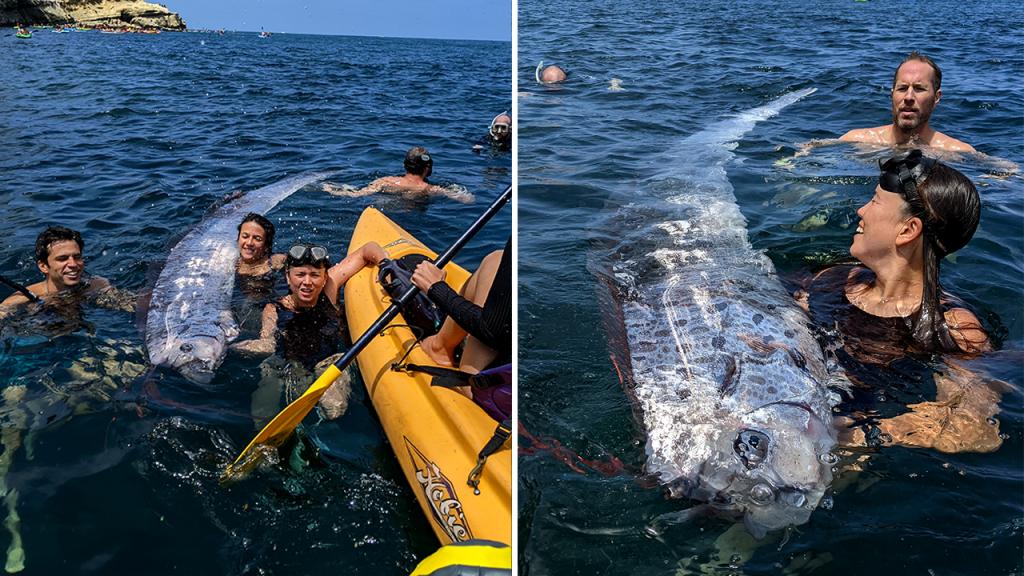A group kayaking and snorkeling in La Jolla, California, spotted a rare 12-foot oarfish that had died. Oarfishes, also known as “doomsday fish,” are long and slender, with some reaching up to 36 feet in length. Only 20 oarfish have been reported in California since 1901, according to the Scripps Institution of Oceanography, UC San Diego. While some believe the oarfish foreshadows natural disasters like earthquakes or tsunamis, scientists have yet to establish a link between the fish’s appearances and such events. Two days after the oarfish was discovered, a 4.6-magnitude earthquake struck Los Angeles, leading to speculation about a possible connection.
Oarfish feed on plankton, crustaceans, and squid using specially evolved gill rakes located in the mouth. After the group that found the dead oarfish coordinated with lifeguards to transport it to a NOAA facility, scientists from NOAA Southwest Fisheries Science Center and Scripps Oceanography planned to conduct a necropsy to determine the cause of death. The fish would then be moved to the Scripps Marine Vertebrate Collection at the University of California San Diego, which houses over two million alcohol-preserved specimens representing more than 5,600 species of fish. The discovery of the oarfish added to the intrigue surrounding the mysterious fish, which is rarely seen alive due to its deep-sea habitat.
Despite its ominous reputation, the connection between oarfish sightings and natural disasters remains speculative. The Ocean Conservancy refers to the oarfish as the “doomsday fish,” yet there is no conclusive evidence linking its presence to seismic events. The sighting of such a rare fish sparked interest and curiosity among researchers and the general public, prompting further study and discussion about the fish’s behavior and biology. The incident highlighted the importance of ocean exploration and research to better understand the biodiversity and ecosystems of the deep sea.
The discovery of the dead oarfish in La Jolla was an unusual occurrence that captivated many people due to the fish’s rarity and mysterious reputation. The subsequent earthquake in Los Angeles fueled speculation about a possible connection, although scientific evidence linking the oarfish to seismic activity is lacking. The coordination between the group that found the oarfish, lifeguards, and scientists showcased the collaborative efforts in studying and preserving marine life. By conducting a necropsy and moving the fish to a research facility, experts hoped to learn more about the oarfish and potentially unlock some of the mysteries surrounding this enigmatic deep-sea creature.
The involvement of organizations like NOAA and Scripps Institution of Oceanography highlighted the significance of scientific research and collaboration in studying marine life. The necropsy of the oarfish aimed to uncover the cause of death and gather valuable information about the fish’s biology and behavior. The decision to preserve the oarfish in a research collection ensured that it would contribute to future studies and enhance our understanding of deep-sea ecosystems. This rare discovery served as a reminder of the importance of conservation efforts and scientific exploration in protecting and learning about the diverse species that inhabit our oceans.
In conclusion, the rare discovery of the dead oarfish in La Jolla sparked intrigue and discussion about the mysterious “doomsday fish.” While its connection to natural disasters remains uncertain, the collaborative efforts of researchers and scientists in studying the oarfish demonstrated the commitment to understanding and preserving marine life. By conducting a necropsy and preserving the oarfish in a research collection, experts hoped to shed light on its biology and contribute to future studies. The incident served as a reminder of the importance of ocean exploration and conservation in safeguarding the rich biodiversity of our oceans.













